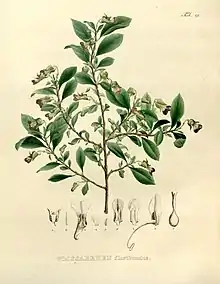Schweiggeria
Schweiggeria is a genus of flowering plants in the violet family Violaceae, with one or two species, found in eastern Brazil.
| Schweiggeria | |
|---|---|
 | |
| Schweiggeria fruticosa | |
| Scientific classification | |
| Kingdom: | Plantae |
| Clade: | Tracheophytes |
| Clade: | Angiosperms |
| Clade: | Eudicots |
| Clade: | Rosids |
| Order: | Malpighiales |
| Family: | Violaceae |
| Subfamily: | Violoideae |
| Tribe: | Violeae |
| Genus: | Schweiggeria Spreng.[1] |
| Type species | |
| Schweiggeria fruticosa Spreng. | |
| Synonyms | |
|
Glossarrhen Mart. | |
Description
Shrubs, with oblanceolate (wider near tip) leaves. White flowers strongly zygomorphic (bilaterally symmetrical), rarely solitary, in axillary fascicles, with caducous corolla with the bottom petal longer than the others and clawed with a spur that is well exserted. The stamens have free filaments, with the lowest two being calcarate (spurred) and possessing a large dorsal connective appendage that is entire and oblong-ovate. In the gynoecium, the style is rostellate (beaked) or lobed. The fruit is a thick-walled capsule with 3 obovoid seeds per carpel.[2]
Taxonomy
The genus Schweiggeria was first described by Sprengel, with the single species Schweiggeria fruticosa, placing it in the family Ionidia, named for the genus Ionidium[3] in 1821.[4] In 1846, Lindley classified both Schweiggeria and Ionidium in Violaceae, within the Violales,[5] although Bentham and Hooker (1862) called the family Violarieae.[6]
Historically Schweiggeria was placed within Violaceae in subfamily Violoideae, tribe Violeae, subtribe Violinae, together with Anchietea, Calyptrion, Noisettia and Viola.[2] But these divisions have been shown to be artificial and not monophyletic. Molecular phylogenetic studies show that Violaceae is best considered as four clades rather than taxonomic ranks. Schweiggeria occurs in Clade I of the family, consisting of Viola, Schweiggeria, Noisettia and Allexis, in which Schweiggeria and Noisettia are monotypic and form a sister group to Viola.[7][8][9]
Etymology
Sprengel named the genus in honour of his colleague August Friedrich Schweigger (1783–1821).[3]
Subdivision
Four species have been described;
- Schweiggeria floribunda A.St.-Hil.
- Schweiggeria fruticosa Spreng.
- Schweiggeria mexicana Schltdl.
- Schweiggeria pauciflora (Mart.) Lindl.
of which two, S. fruticosa and S. mexicana are accepted by Plants of the World Online, considering S. floribunda and S. pauciflora as synonyms of S. fruticosa.[10] Other authors consider Schweiggeria to be monotypic for S. fruticosa.[2][7][11][12]
Distribution and habitat
Eastern Brazil.[10]
References
Bibliography
- Ballard, Harvey E; Paula-Souza, Juliana de; Wahlert, Gregory A (2013). "Violaceae". In Kubitzki, Klaus (ed.). Flowering Plants. 11 Eudicots: Malpighiales. Springer Science & Business Media. pp. 303–322. ISBN 978-3-642-39417-1.(Also preview at Springer)
- Bentham, G.; Hooker, J.D. (1862). "Violarieae". Genera plantarum ad exemplaria imprimis in herbariis kewensibus servata definita (3 vols.). 1. London: L Reeve & Co. pp. 114–121.CS1 maint: ref=harv (link)
- Byng, James W. (2014). "Violaceae". The Flowering Plants Handbook: A practical guide to families and genera of the world. Plant Gateway Ltd. pp. 238–239. ISBN 978-0-9929993-1-5.CS1 maint: ref=harv (link)
- Christenhusz, Maarten J. M.; Fay, Michael F.; Chase, Mark W. (2017). "Violaceae". Plants of the World: An Illustrated Encyclopedia of Vascular Plants. University of Chicago Press. pp. 324–325. ISBN 978-0-226-52292-0.
- Lindley, John (1846). "Violaceae". The Vegetable Kingdom: or, The structure, classification, and uses of plants, illustrated upon the natural system (1st ed.). London: Bradbury. pp. 338–339.CS1 maint: ref=harv (link)
- Sprengel, Kurt Polycarp Joachim (1820–1823). "Ionidia: Schweiggeria fruticosa". Neue Entdeckungen im ganzen Umfang der Pflanzenkunde 3 vols. Leipzig: F. Fleischer. pp. I: 167–168.CS1 maint: ref=harv (link)
- Ballard, Harvey E.; Sytsma, Kenneth J.; Kowal, Robert R. (October 1998). "Shrinking the Violets: Phylogenetic Relationships of Infrageneric Groups in Viola (Violaceae) Based on Internal Transcribed Spacer DNA Sequences" (PDF). Systematic Botany. 23 (4): 439. doi:10.2307/2419376. JSTOR 2419376.
- Wahlert, Gregory A.; Marcussen, Thomas; de Paula-Souza, Juliana; Feng, Min; Ballard, Harvey E. (1 March 2014). "A Phylogeny of the Violaceae (Malpighiales) Inferred from Plastid DNA Sequences: Implications for Generic Diversity and Intrafamilial Classification". Systematic Botany. 39 (1): 239–252. doi:10.1600/036364414X678008. S2CID 86452033.
- Yockteng, R.; Jr Ballard, H. E.; Mansion, G.; Dajoz, I.; Nadot, S. (1 November 2003). "Relationships among pansies ( Viola section Melanium ) investigated using ITS and ISSR markers". Plant Systematics and Evolution. 241 (3–4): 153–170. doi:10.1007/s00606-003-0045-7. JSTOR 23645153. S2CID 25104565.
- WFO (2019). "Schweiggeria Spreng". World Flora Online. Retrieved 2 April 2020.CS1 maint: ref=harv (link)
- POTWO. "Schweiggeria Spreng". Plants of the World Online. Royal Botanic Gardens, Kew. Retrieved 2 April 2020.
- IPNI. "Schweiggeria Spreng., Neue Entdeck. Pflanzenk. 2: 167 (1821)". Royal Botanic Gardens, Kew. Retrieved 3 April 2020.
External links
| Wikimedia Commons has media related to Schweiggeria. |